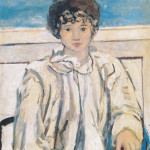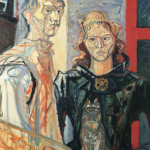Exhibition
in Bern 7 / Switzerland
- Max Gubler: Knabe mit Hut, 1930, Zürich Öl auf Leinwand, 107 x 93 cm Fondation Saner Studen, Stiftung für Schweizer Kunst © Eduard, Ernst und Max Gubler-Stiftung, Zürich
- Max Gubler: Maria Gubler, 1959, Unterengstringen Öl auf Leinwand, 130 x 97 cm © Eduard, Ernst und Max Gubler-Stiftung, Zürich
- Max Gubler: Selbstbildnis mit Hut, 1951, Unterengstringen Öl auf Leinwand, 65 x 54 cm, Fondation Saner Studen, Stiftung für Schweizer Kunst © Eduard, Ernst und Max Gubler-Stiftung, Zürich
- Max Gubler: Doppelbildnis mit Katze, um 1952, Unterengstringen Öl auf Leinwand, 162 x 130 cm, Museum zu Allerheiligen, Schaffhausen, Kunstverein Schaffhausen © Eduard, Ernst und Max Gubler-Stiftung, Zürich
- Max Gubler: Stehender Akt und Selbstbildnis im Spiegel, um 1949/50, Unterengstringen Öl auf Leinwand, 81 x 65 cm, Privatbesitz © Eduard, Ernst und Max Gubler-Stiftung, Zürich
Gubler in His Entirety
Right into the 1960s, Max Gubler (1898 – 1973) was seen as the “sole genius of Swiss painting.” In the 1950s, he was probably the most celebrated and most exhibited artist in Switzerland. Max Frisch and Friedrich Dürrenmatt were among his great admirers. But still we have never had the chance to review his oeuvre in its entirety because his late work was kept under lock and key until only recently. The exhibition “Max Gubler: A Life’s Work” now makes it possible to gain a comprehensive view of the artist’s brilliant painting oeuvre.
Opinions on the 20th-century
Swiss artist Max Gubler were long uniquely controversial. Reviews of his work span the superlative concerning artistic quality and goals during the 1940s and 1950s to totally relativizing and denigrating it after his decease. During his lifetime, Max Gubler was extolled as the Swiss counterpart to Van Gogh and Edvard Munch, and he represented Switzerland at the Venice Biennial. The key critic of his work, the influential art historian and author Gotthard Jedlicka, declared him to be THE Swiss artist of the 20th century. However, after he died, art critics relentless attacked Gubler, and did so without any knowledge of the work he produced during the last years in which he was still producing art. It wasn’t until the end of the 1990s that we began to revise this view of the artist, when Gubler’s work again began to be seen as relevant to the present in the context of the “Neue Wilden” or neo-expressionism (in Switzerland represented by artists such as Martin Disler, Miriam Cahn, or Sonja Sekula).
Late Work Kept Under Lock and Key
In the 20th century it is likewise unique that, in the case of a Swiss artist who was so enthusiastically celebrated during his lifetime, his oeuvre was split up into two parts until recently. On the one hand, it comprised an “official legacy” of 2,258 paintings executed by the artist until late fall in 1957. But 375 further paintings completed by the artist between 1958 and 1961 were put into storage. He had painted them during the time of his physical and mental illness, and they were locked away on request of his heirs because they thought they were not suitable to show to the public. In 1981, the heirs came to an agreement with the Swiss Institute for Art Research SIK-ISEA in Zurich that the late legacy would be kept under lock and key for a period of 30 years. This term was, in the end, even extended until October 2014 for the finalization of Bettina Brand-Claussen and Peter Cornelius Claussen’s publication in which they have researched the “unknown late works” of the artist’s career. Shortly after the book was published, works were selected for a presentation at the Museum zu Allerheiligen in Schaffhausen from October 2014 until February 2015. This exhibition was not intended as a retrospective, however.
Giving Reality a Visual Image
For a long time, Max Gubler’s art was viewed from the angle of the history of his health situation. What was considered strange, enigmatic, or extraordinary in his work was interpreted as a manifestation of his unstable mental condition. But painting in the 20th century is always also a confrontation with the crises of this era too. Hence the exhibition redirects our attention to the development of Gubler’s oeuvre with more than 100 paintings from all the phases of his artistic career. Our goal is to rediscover anew a brilliant oeuvre of modernism, one that bears the stamp of expressive realism and an artist’s struggle to articulate reality in a visual vocabulary. Gubler explored new forms of realism and ultimately ventured into the realms of abstract art. In the exhibition, Gubler’s artistic development will be traced in seven thematically organized rooms. The central space in which the staircase is situated is devoted to his wife, Maria. He painted her over 260 times. Otherwise, the show traces the thematic aspects of the artist’s neo-objective early work, figural compositions, landscapes, self-portraits, still lifes, and the paintings of his studio. Especially Gubler’s works in series are remarkable. When he became interested in a motif he would execute it in up to twelve variant ways.
Springboard for the Show is the High-Class Legacy of Siblings Ruth and Hans-Rudolf Kull
The point of departure for the comprehensive overview of this artist’s work is the legacy of the siblings Ruth and Hans-Rudolf Kull, which is part of the Kunstmuseum Bern Collection since 2010. They followed Max Gubler’s development and his work with great interest and enthusiasm, accruing a collection of exceptional artworks. Hence we have dedicated this exhibition to them.
Opening hours Tues 10 am – 9 pm, Wed-Sun 10 am – 5 pm
Max Gubler – Ein Lebenswerk
Der ganze Gubler
Max Gubler (1898 – 1973) galt bis in die 1960er Jahre als “einziges Genie der Schweizer Malerei”. In den 1950er-Jahren war er der in der Schweiz wohl am meisten ausgestellte und gefeierte Gegenwartskünstler, dem auch Max Frisch und Friedrich Dürrenmatt grösste Verehrung entgegenbrachten. Und doch liess sich sein Schaffen noch nie als Ganzes beurteilen, denn sein Spätwerk wurde unter Verschluss gehalten – bis vor kurzem. Die Ausstellung “Max Gubler. Ein Lebenswerk” ermöglicht jetzt zum ersten Mal einen umfassenden Blick auf das fulminante malerische Œuvre von Gubler.
Keine andere Schweizer Künstlerpersönlichkeit des 20. Jahrhunderts ist so kontrovers beurteilt worden wie der Maler Max Gubler. Das Urteil über Gublers Oeuvre reicht vom höchsten Superlativ in puncto Qualität und Anspruch in den 1940er- und 1950er-Jahren bis zu dessen totaler Relativierung und Degradierung nach seinem Tod. Zu Lebzeiten wurde Gubler als der Schweizer Van Gogh und der Schweizer Edvard Munch apostrophiert und hat die Schweiz an der Biennale in Venedig vertreten. Von seinem Hauptrezensenten, dem einflussreichen Kunsthistoriker und Autor Gotthard Jedlicka, wurde er zu DEM Schweizer Maler des 20. Jahrhunderts erklärt. Nach seinem Tod fielen die Kritiker jedoch schonungslos über Gubler her, dies in Unkenntnis der Werke Gublers der letzten vier Schaffensjahre. Die Revision dieser Negativwahrnehmung setzte schliesslich Ende der 1990er-Jahre ein mit der Erkenntnis, dass Gublers Werk im Kontext der “Neuen Wilden” (in der Schweiz etwa Martin Disler, Miriam Cahn oder Sonja Sekula) neue Aktualität erhalten könnte.
Unter Verschluss gehaltenes Spätwerk
Einzigartig für einen zu Lebzeiten hochgefeierten Schweizer Künstler im 20. Jahrhundert ist zudem die Tatsache, dass Gublers Oeuvre bis vor kurzem zweigeteilt war. Es umfasste zum einen das “offizielle” bis zum Spätherbst 1957 entstandene Werk mit 2’258 Gemälde. 375 weitere Gemälde, die Gubler zwischen 1958 und 1961 während seiner physischen und psychischen Krankheit gemalt hatte, wurden auf Wunsch seiner Erben eingelagert, weil sie diese als nicht ausstellungswürdig taxierten. 1981 vereinbarten die Erben mit dem Schweizerischen Institut für Kunstwissenschaft SIK-ISEA in Zürich, dass das Konvolut für die Dauer von 30 Jahren unter Verschluss zu halten sei. Diese Frist wurde schliesslich bis zum Abschluss der Publikation von Bettina Brand-Claussen und Peter Cornelius Claussen, die das “unbekannte Spätwerk” wissenschaftlich erforschten, bis Oktober 2014 verlängert. Kurz nach der Erscheinung des Buches wurde erstmals eine Auswahl aus dem Spätwerk im Museum zu Allerheiligen in Schaffhausen von Oktober 2014 bis Februar 2015 gezeigt. Die Ausstellung war aber nicht als Retrospektive angelegt.
Die Wirklichkeit ins Bild bekommen
Das Werk Max Gublers wurde lange Zeit sehr an seiner Krankheitsgeschichte gemessen. Was an seinen Werken sonderbar, rätselhaft und aussergewöhnlich war, wurde als Zeichen psychischer Labilität gewertet. Doch Malen im 20. Jahrhunderts ist immer auch eine Auseinandersetzung mit den Krisen dieser Epoche. Deshalb will die Ausstellung mit etwas über 100 Gemälden aus allen Schaffensphasen den Blick wieder auf die künstlerische Entwicklung des Werkes lenken. Es gilt dabei ein fulminantes Œuvre der Moderne neu zu entdecken, das geprägt ist von expressivem Realismus und dem Ringen darum, die Wirklichkeit ins Bild zu bringen. Gubler hat dabei neue Formen des Realismus ausgelotet und stiess schliesslich zur Ungegenständlichkeit vor. Gublers künstlerische Entwicklung wird in sieben Themenräumen veranschaulicht. Die zentrale Treppenhalle ist dabei seiner Frau Maria gewidmet, die er über 260 Mal gemalt hat. Des Weiteren ist die Ausstellung in die Themen neusachliches Frühwerk, Figurenbilder, Landschaften, Selbstporträts, Stillleben und Atelierbilder gegliedert. Augenfällig ist dabei Gublers Arbeiten in Werkserien. Er spielt ein einmal gefundenes Motiv in bis zu zwölf Variationen durch.
Hochkarätiges Legat der Geschwister Kull als Ausgangspunkt
Ein Ausgangspunkt für den umfassenden Werküberblick ist das Legat der Geschwister Ruth und Hans-Rudolf Kull, das 2010 in die Sammlung des Kunstmuseums Bern gelangte. Sie haben das Werk und die Entwicklung dieses Malers mit grosser Anteilnahme und Begeisterung begleitet und eine Sammlung mit herausragenden Werken zusammengetragen. Ihnen ist deshalb die Ausstellung gewidmet.
Öffnungszeiten Di 10 – 21 Uhr, Mi-So 10 – 17 Uhr
Location:
Kunstmuseum Bern
Hodlerstrasse 8 - 12
3000 Bern 7
Switzerland






